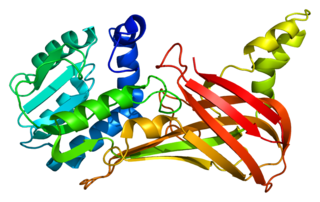
Myosin VIIA is protein that in humans is encoded by the MYO7A gene. Myosin VIIA is a member of the unconventional myosin superfamily of proteins. Myosins are actin binding molecular motors that use the enzymatic conversion of ATP - ADP + inorganic phosphate (Pi) to provide the energy for movement.

The sodium/glucose cotransporter 2 (SGLT2) is a protein that in humans is encoded by the SLC5A2 gene.

Structural maintenance of chromosomes protein 3 (SMC3) is a protein that in humans is encoded by the SMC3 gene. SMC3 is a subunit of the Cohesin complex which mediates sister chromatid cohesion, homologous recombination and DNA looping. Cohesin is formed of SMC3, SMC1, RAD21 and either SA1 or SA2. In humans, SMC3 is present in all cohesin complexes whereas there are multiple paralogs for the other subunits.

Centromere protein J is a protein that in humans is encoded by the CENPJ gene. It is also known as centrosomal P4.1-associated protein (CPAP). During cell division, this protein plays a structural role in the maintenance of centrosome integrity and normal spindle morphology, and it is involved in microtubule disassembly at the centrosome. This protein can function as a transcriptional coactivator in the Stat5 signaling pathway and also as a coactivator of NF-kappaB-mediated transcription, likely via its interaction with the coactivator p300/CREB-binding protein.

Whirlin is a protein that in humans is encoded by the DFNB31 gene.

Alpha-tectorin is a protein that in humans is encoded by the TECTA gene.

Leucine-rich repeats and immunoglobulin-like domains protein 1 is a protein that in humans is encoded by the LRIG1 gene. It encodes a transmembrane protein that has been shown to interact with receptor tyrosine kinases of the EGFR family and with MET and RET.

Kaptin is a protein that in humans is encoded by the KPTN gene.

RING finger protein 10 is a protein that in humans is encoded by the RNF10 gene.

Deoxyribonuclease-1-like 2 is an enzyme that in humans is encoded by the DNASE1L2 gene.

Protein arginine N-methyltransferase 3 is an enzyme that in humans is encoded by the PRMT3 gene.

SLX4 is a protein involved in DNA repair, where it has important roles in the final steps of homologous recombination. Mutations in the gene are associated with the disease Fanconi anemia.

AP-4 complex subunit epsilon-1 is a protein that in humans is encoded by the AP4E1 gene.

Putative sodium-coupled neutral amino acid transporter 10, also known as solute carrier family 38 member 10, is a protein that in humans is encoded by the SLC38A10 gene.

WD repeat domain 47 is a protein that in humans is encoded by the WDR47 gene.

Protein FAM134C is a protein that in humans is encoded by the FAM134C gene.

CSRP2 binding protein is a protein that in humans is encoded by the CSRP2BP gene.

Mitochondrial methionyl-tRNA formyltransferase is a protein that in humans is encoded by the MTFMT gene.

Mitochondrial 2-oxodicarboxylate carrier also known as solute carrier family 25 member 21 (SLC25A21) is a protein that in humans is encoded by the SLC25A21 gene.

NOP2/Sun domain family, member 2 is a protein that in humans is encoded by the NSUN2 gene. Alternatively spliced transcript variants encoding different isoforms have been noted for the gene.


















